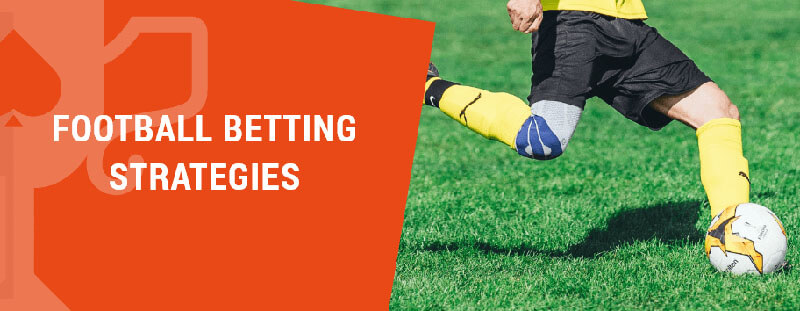Football betting has become more accessible than ever before, thanks to the internet. However, most punters still lose money despite having access to a wealth of information.
In this article, we will share with you five of the best football betting strategies that have been researched over the years to help you turn a profit. Yes, that’s correct. Betting strategies are structured approaches to gambling that aim to produce a profit.
However, it’s important to note that no betting strategy can guarantee a profit as the house always has an edge in games of probability with fixed odds.
Top football betting strategies
How do football strategies improve our results?
The core difference between being a regular bettor and following a trading strategy is simply the fact that the strategic approach tends to follow a consistent set of rules. This approach won’t generally tee you up for a one-off payday but, over an extended period, you should be winning on a more consistent basis. That’s the logic at least.
Unlike regular bettors, professionals are following a consistent set of rules that guide their strategic approach. While this approach may not lead to a one-off payday, it can result in more consistent wins over an extended period of time.
Perhaps you followed the same set of rules and had a strategy, but it just wasn’t a good one. Don’t worry though, we’ve got a few of the best and most trusted football trading strategies for you to cast your eyes over – and one to avoid!
Goliath bets
Although Goliath bets are not guaranteed to make you money, your odds of making a profit are greatly improved.
By tradition, a Goliath bet is grounded on eight choices – let’s say it is eight teams to win. Typically, in this situation, you’d result in an eight-fold accumulator but by using the Goliath option your bet is broken down into 247 dissimilar results. These 247 selections cover every probable mixture from doubles up to an eight-fold win. As such, your stake is multiplied so a 10p stake will actually cost you $24.70.

Even though that’s a dramatic ramp-up of stake, just two selections approaching will see you with about winnings (not essentially profit) even nonetheless six of your eight choices were incorrect. The more of your selections you get correct, the more you win and the earnings can be massive. It’s this final point why your football knowledge and research are still vital.
Arbitrage betting
Arbitrage betting is possibly something you’ve heard of but maybe never supposed to be workable. Arbitrage betting is all attentive on take advantage of the difference in odds across different bookies. Each bookmaker put its own statistical method to setting odds for a match.
As an outcome, you will rarely find matches where both results are estimated in a manner that potentials a profit – irrespective of which side wins. Let’s look at a draw-no-bet instance from the upcoming League One fixtures with the decimal odds format:
Sunderland to win is priced at 1.53 with Bookie1 whereas Bristol Rovers are available at 3.10 with Bookie2. By strategically adjusting your stakes you can guarantee a profit:
- $66.95 stake * 1.53 = $102.43
- $33.05 stake * 3.10 = $102.46
With these incomes, your outlay is a combined $100 with a minimum return of $102.43; a nearly 2.5% return on investment. It doesn’t look like much but it’s a banker for money-making returns whilst you will also find more appealing bets as you discover chances. A 2.5% return for an afternoon’s work is also to a certain degree higher than a bank would pay.
Matched betting
Matched betting promises you a profit. So how does it work? You’ll maybe be well mindful of all the free bet suggestions advertised by the many bookies. Well, matched betting only works when a free bet is accessible.
To start, you must find a free bet – most bookmakers proposition these on sign-up. At that point, it’s a case of finding the right event to stake on; you’ll need something that doesn’t have a pure favorite. It’s then an occasion to use your free bet to back a winner while utilizing a betting exchange website to ‘lay’ against the team you’ve backed. A lay bet is basically saying I think Team X will not win thus covering a loss and draw. You now have all three outcomes covered.

Certainly, you need to analyze the relevant stake to lay whilst your expanse at risk – called the lay liability – is higher than the stake as it needs to cover potential losses because of how betting exchanges work.
Don’t worry though for the reason that profit is guaranteed! Let’s review this in an instance:
Let’s say today, Kilmarnock host Dundee United. Your free bet, which in this example will be via Bookie1, is to back the home side i.e. I think Kilmarnock will win. The odds are 2.30. You can lay the bet i.e. I think Kilmarnock will fail to win with Bookie2 at 2.42.
- $10 free bet stake * 2.30 = $23 – $10 as the stake isn’t returned = $13
- Lay $5.42 * 2.42 = $13.12 (your liability is $7.70, the difference between $13.12 and $5.42, which is the backers’ stake).
If your ‘back’ bet wins, you earn $13.00 profit from Bookie1 but lose $7.70 on the Bookie2 lay bet i.e. you’ve made $5.30 profit. If, nevertheless, Kilmarnock loses or draws then you win nothing on the Bookie1 side but scoop your profit from Bookie2 at $5.42 (minus a small commission).
The only extra thing to study is that most free bets need you to place a qualifying bet. Follow the same back and lay process as above and you will make a very minimal loss – typically pence – which will be more than covered in the second bet.
Price boost exploitation
Approximately each online bookies offers their customers enhanced odds on a daily basis. 99% of punters who take the bet do just that, they gamble in suspense to win at the improved price. The 1% that remains knows how to exploit these suggestions for positive returns. We know that bookmakers price events in diverse methods, which can present prospects of their own where you can cover all results for a win.
Moreover, these bets are not risk-free yet with accounts likely to be limited and, possibly, closed. Price improvements can from time to time present the same opportunities but without the risk of account implications. The aim is that bookies want you to take their boosted odds.
The technique to this plan is to place a ‘back’ bet on the boosted odds and then head somewhere else to cover the other likely outcomes; classically, this will be done via betting exchanges and, specifically, using a lay bet. With the allowance of odds moving and liquidity problems, this strategy is a banker; returns are generally smaller though.
Lay betting strategies
We’ve just touched on lay bets in the above. Basically, they are just a method of saying ‘that won’t happen’ rather than the traditional betting approach of ‘this will happen’. The reason for a lay bet does present chance though and it’s something plenty of bettors do. We’ll talk about two cases of how to use lay betting as a strategy.
The first is focused on laying accurate scores. It’s well-recognized that guessing the exact scoreline of a football competition is one of the toughest bets to win. With that nugget planted firmly in your brain, lay bets let you say ‘it won’t be that score’. Indubitably, there are plenty of score potentials in any given match meaning you can have some lay bets placed at once. The only way you lose is when one of the scores you lay really washes in as the correct score.
The second of the lay football trading tactics we look at attention on pointing specific in-play games. Initially, you’ll be looking for matches where you have a weighty favorite (cup matches can work well). The outlook of laying against a League Two side playing, for case, Man City is far from exciting. Your odds would be atrocious. If the underdog occurs to take the lead those odds start to advance. Finally, it turns out to be like a handicap market. You now have the choice to lay against the underdog with the idea that a meaningfully stronger team will come back.
Expectantly, we’ve covered the logic of a ‘lay bet’ in the above piece regarding matched betting since you’ll be using it again here. Price boost exploitation is comparable to arbitrage betting and matched betting – but it has two big things in its favor over those. Where matched betting is worried, you’re conditional on having free bets – that’s not the occasion here meaning nor is the qualifying bet. With arbitrage bets, you depend on an unusually weighted set of odds-on offers from a bookmaker – with price boosts, the bookie is purposely giving you this edge at the same time as the risk of being ‘gubbed’ (having your account restricted) is virtually zero. Why would a bookmaker do that? Pure and basically for the reason that most people won’t exploit the chance it creates and instead will just wager extra funds in a good old-fashioned gamble.
Accordingly, in regular circumstances, prices on offer from bookies won’t vary hugely – although there is some opportunity on offer as mentioned earlier – because across the board bookmakers don’t want to create an industry that can be fiddled. Price boosts, still, are planned to pull in new money and are only on handpicked events meaning the industry will remain in a healthy position. For people in the know, it’s time to get winning. This example clarifies how it is done:
In the initial Premier League fixtures, Everton travel to face Tottenham with a current price of 4.0 to win with Bookie1. Let’s quickly forward a couple of weeks and visualize they’re boosted to 5.0. You can lay against an Everton win i.e. Spurs to win or draw with the Bookie2 Exchange at 4.5. You’re now into guaranteed profit territory:
- $20 stake on the price boost * 5.0 = $100
- Lay $22.32 * 4.5 = $100.44 (your liability is $78.12)
If your ‘back’ stake wins, you earn $20 profit from Bookie1 but lose $78.12 on the lay bet i.e. you’ve made $1.88 profit. If, yet, Everton fails to win then you win nothing on the Bookie1 side but scoop your profit from your lay bet giving you $1.87 profit after a 2% commission.
Yet again, like the Arbitrage bets, the returns aren’t at all times colossal but price improvements are available several times a day meaning profits can soon mount up with a lot of those who follow this method making well north of $100 per week.
Player trading platforms
The next stop on our journey of the best football trading strategies derives with somewhat of a twist; player trading platforms. Football Index was the first to market with this sort of ‘gambling meets fantasy football’ model; here and now though sites like Footstock and Sorare have also emerged in an alike space. What are they?
Well, the specifics associated with each one depend on what site you look at since they are all different. The style of making money is alike though. In truly basic terms, player trading platforms let you buy real-life footballers (in a virtual world) who are then valued based on their actual performances in actual games through data like that captured by Opta. Performance can be rewarded through the payment of dividends or prizes and, as with stock markets, capital appreciation i.e. buy low, sell high is the end game.
The Kelly Criterion method
Here we look at a trading strategy that was developed to profit in the financial world. Its transition to football betting works seamlessly and, as football trading strategies go, although it will take some getting used to though, it’s perhaps the one with the best instruction to help you build sustainable profit.

The main motive for this is since the Kelly Criterion method is all about probability and bankroll management; this means you’ll necessity to master a few mathematical calculations before you can truly set about using it. We realize that may not be uber pleasing to a lot of people but the flip side is that you can apply the tactic to pretty much any event you want.
The preliminary place for the Kelly Criterion strategy is locating an event you’d like to bet on; somehow, we can name it a straightforward match result bet. Initially, there are two pieces of information you will need; the first is given to you by the bookmaker – the odds. The second will take a bit more effort; you need to work out the actual probability. There are a lot of ways to do this so we won’t tread that path right now. These two elements form the basis of the first mathematical calculation, which shows the value of a bet.
If the worth of the first calculation is negative then you do not bet on the event. If the value is positive then you can move on to the second calculation, which determines how much money you should look to stake. Certainly, everyone will have different bankrolls and therefore your answer will be expressed as a percentage. This will give you a third and final calculation to establish how much cash you need to stake.
For the determinations of our calculation, we’re using the Bookie1 odds of 2.60 for Burnley to win at home against Fulham. We’ll be using a probability of 42% and a bankroll of $500.
The first calculation:
The structure of the calculation is ‘(Probability as a decimal * decimal Odds)-1 = Value‘.
- With our specific selection it is ‘(0.42 * 2.60)-1 = 0.092 i.e. 9.2%
As this is a positive number, we move on to calculation two.
The second calculation:
The assembly of the calculation is ‘Answer of calculation 1 in decimal form/ (odds – 1) = Stake percentage’
- With our specific choice it is ‘0.092/(2.60 – 1) = 0.0575 i.e. 5.75%
The final calculation:
The structure of the calculation is ‘Bankroll * Answer of calculation 2= Stake’
- With our specific selection it is ‘$500 * 5.75% = $28.75’
Conclusion
Finally, it’s important to note we need to use strategy in football betting since it benefits us to make informed decisions, excluding the risk of losing in the long run, realizing which bets to place and how much money to risk, and taking advantage of overpriced odds and betting lines.
- Suggested read: Tips on successful hockey betting; like a PRO
There you have it, our overview of some of the football betting strategies that could help transform the way you bet.
Good luck.
Leylaj





